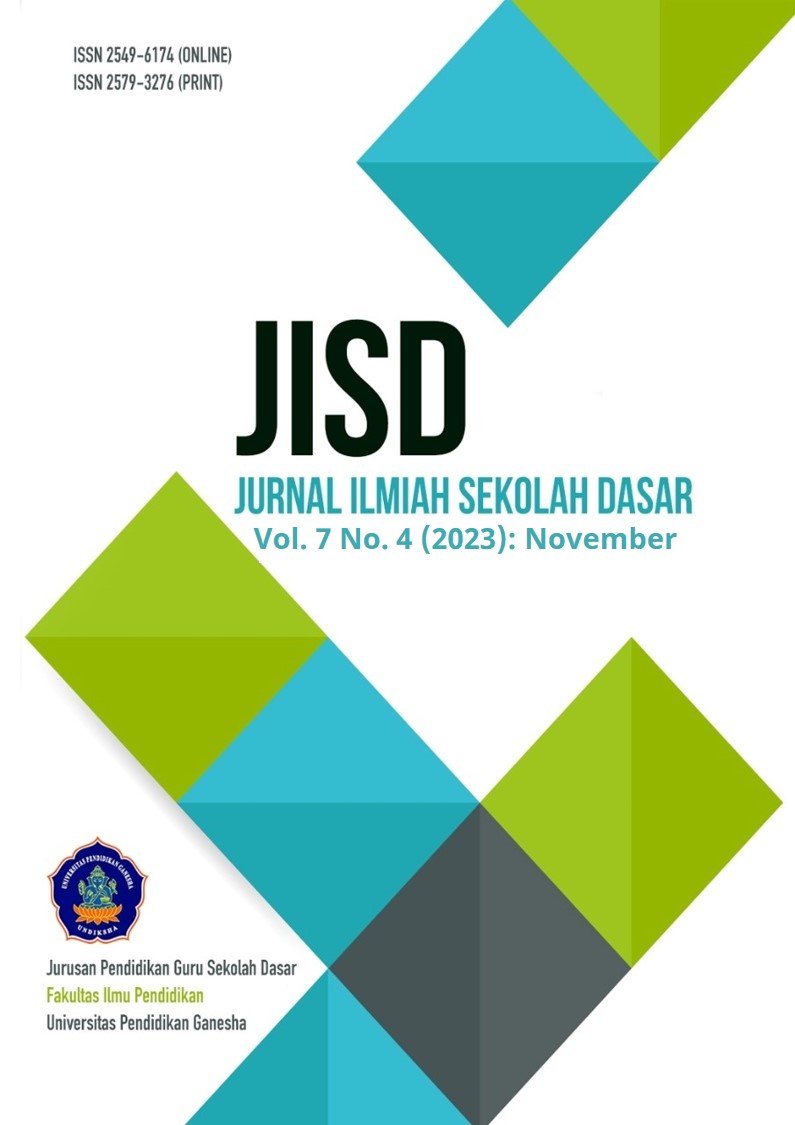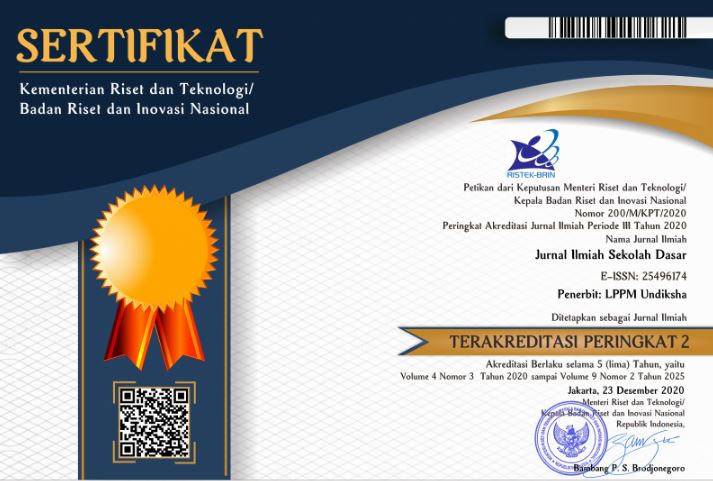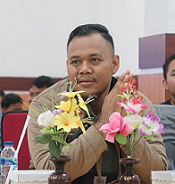Crossword Puzzle Learning Media to Improve Mastery of Indonesian Vocabulary in Elementary School
DOI:
https://doi.org/10.23887/jisd.v7i4.61292Keywords:
Learning Media, Crossword Puzzle, Indonesian VocabularyAbstract
The use of learning media in the teaching and learning process is very important. This can help in creating an effective teaching and learning situation. This study aims to analyze the effect of Crossword Puzzle learning media in increasing elementary school students' Indonesian vocabulary knowledge. This article is a quantitative study using a quasi-experimental approach. The research sample was class IV, totaling 38 students. The 38 students were divided into 2 groups, namely 20 experimental classes and 18 control classes. The selected research instrument is a test in the form of pretest questions and posttest questions that will be given to students. While data analysis uses 2 prerequisite tests, namely the homogeneity test and the normality test. Normality test, data is tested using Shapiro Wilk. While the homogeneity test can be carried out by testing the homogeneity of variants in the IBM SPSS 20 software. Then data analysis is continued with statistical analysis of the t test, namely the paired sample t-test. The research results found that there was an influence of the Crossword Puzzle learning media on increasing elementary school students' mastery of Indonesian vocabulary. It was concluded that the Crossword Puzzle learning media could improve elementary school students' mastery of Indonesian vocabulary.
References
Al Mawaddah, A. W., Hidayat, M. T., Amin, S. M., & Hartatik, S. (2021). Pengaruh Penggunaan Media Pembelajaran Quizizz Terhadap Hasil Belajar Siswa Pada Mata Pelajaran Matematika Melalui Daring Di Sekolah Dasar. Jurnal Basicedu, 5(5), 3109–3116. https://doi.org/10.31004/Basicedu.V5i5.1288. DOI: https://doi.org/10.31004/basicedu.v5i5.1288
Azis, M., & Yusal, S. (2022). Pengaruh Penggunaan Metode Pembelajaran Crozzword Puzzle Terhadap Hasil Belajar Ips Siswa Kelas V Sd Inpres Panaikang I/1 Kota Makassar: Hasil Pretest sebelum Menggunakan Metode Pembelajaran terhadap Hasil Belajar IPS Siswa Kelas VB SD Inpres Panaikang I/. Adi Widya: Jurnal Pendidikan Dasar, 7(1), 85–92. https://doi.org/10.25078/aw.v7iI.701. DOI: https://doi.org/10.25078/aw.v7iI.701
Fadhillah, N., & Khoriyah, R. (2022). Efektivitas Model Crossword Puzzle Untuk Meningkatkan Motivasi Belajar Siswa Pada Mata Pelajaran Al. Qur ’ An Hadist, 5(7), 2542–2546. https://doi.org/10.54371/jiip.v5i7.698. DOI: https://doi.org/10.54371/jiip.v5i7.698
Fidiyanti, L. (2020). Penggunaan Media Pembelajaran Flashcard Untuk Meningkatkan Penguasaan Vocabulary Dengan Materi Narrrative Text. Journal of Education Action Research, 4(1), 42. https://doi.org/10.23887/jear.v4i1.23437. DOI: https://doi.org/10.23887/jear.v4i1.23437
Halidjah, S., & Pranata, R. (2021). Development Of Indonesian Language Teaching Materials Based On Google Classroom In Primary Schools. Journal Of Education Technology, 5(2), 298–306. https://doi.org/10.23887/Jet.V5i2.33933. DOI: https://doi.org/10.23887/jet.v5i2.33933
Hidayat, N. (2016). Improving Students’ Vocabulary Achievement through Word Game. JEES (Journal of English Educators Society), 1(2), 95–104. https://doi.org/10.21070/jees.v1i2.446. DOI: https://doi.org/10.21070/jees.v1i2.446
Hien, L. T. N. (2021). Communicative Language Teaching In Teaching Esl For University Students. Journal Of English Language Teaching And Applied Linguistics, 3(6), 49–57. https://doi.org/10.32996/Jeltal.2021.3.6.7. DOI: https://doi.org/10.32996/jeltal.2021.3.6.7
Ichsan, I. Z., Purwanto, A., & Rahmayanti, H. (2021). E-learning in new normal covid-19 era: Measure hots and pro-environmental behavior about environmental pollution. International Journal of Evaluation and Research in Education, 10(3), 790–797. https://doi.org/10.11591/ijere.v10i3.21382. DOI: https://doi.org/10.11591/ijere.v10i3.21382
Johansson, E. (2020). The Assessment of Higher-order Thinking Skills in Online EFL Courses: A Quantitative Content Analysis. NJES Nordic Journal of English Studies, 19(1), 224–256. https://doi.org/10.35360/njes.519. DOI: https://doi.org/10.35360/njes.519
Joshi, P. S. (2021). Visualization and crossword: In-class exercise---an active learning strategy. Journal of Engineering Education Transformations, 35(2), 12–17. https://doi.org/10.16920/jeet/2021/v35i2/144011. DOI: https://doi.org/10.16920/jeet/2021/v35i2/22067
Kassem, M. A. M. (2018). The Effect of Using Blackboard on English Majors’ Writing Proficiency and Attitudes. International Journal of Applied Linguistics and English Literature, 7(6), 73. https://doi.org/10.7575/aiac.ijalel.v.7n.6p.73. DOI: https://doi.org/10.7575/aiac.ijalel.v.7n.6p.73
Kurniawan, E., Nizzam, M., Fatikh, M. A., & Rofiq, M. H. (2022). Pengaruh Penggunaan Media Audio Visual Terhadap Hasil Belajar Kosa Kata Bahasa Inggris Siswa Kelas II MI Dwi Dasa Warsa. Attadrib: Jurnal Pendidikan Guru Madrasah Ibtidaiyah, 5(1), 27–38. https://doi.org/10.54069/attadrib.v5i1.226. DOI: https://doi.org/10.54069/attadrib.v5i1.226
Mahanani, T. D. (2020). Penggunaan Kartu Kata Bergambar Untuk Meningkatkan Ketrampilan Berbicara Anak Autis. Pendidikan Khusus, 1–5. https://ejournal.unesa.ac.id/index.php/jurnal-pendidikan-khusus/article/view/35032.
Maulana, F., Irfani, F., & Barat, J. (2022). Tarbiatuna. Journal Of Islamic Education Studies Tarbiatuna: Journal Of Islamic Education Studies, 2, 29–56. https://doi.org/10.22373/Lj.V4i1.1866.2. DOI: https://doi.org/10.47467/tarbiatuna.v2i1.1021
Mawardhani, M. A., Lita, A., Dewi, S., & Andjariani, E. W. (2023). Pengaruh Media Pembelajaran Crossword Puzzle Terhadap Hasil Belajar Kelas V Sd. JISIP (Jurnal Ilmu Sosial Dan Pendidikan), 7(2), 1084–1090. https://doi.org/10.58258/Jisip.V7i1.4737/Http. DOI: https://doi.org/10.58258/jime.v9i1.4744
Megawati, I., Basikin, & Wibawa, S. (2020). Teacher’s strategies of managing classroom and students’ response: A case study. Elementary Education Online, 19(2), 20–33. https://doi.org/10.17051/ilkonline.2020.02.103.
Mshayisa, V. V. (2020). Students’ perceptions of Plickers and crossword puzzles in undergraduate studies. Journal of Food Science Education, 19(2), 49–58. https://doi.org/10.1111/1541-4329.12179. DOI: https://doi.org/10.1111/1541-4329.12179
Noble, C., Sala, G., Peter, M., Lingwood, J., Rowland, C., Gobet, F., & Pine, J. (2019). The Impact Of Shared Book Reading On Children’s Language Skills: A Meta-Analysis. Educational Research Review, 28, 1–10. https://doi.org/10.1016/j.edurev.2019.100290. DOI: https://doi.org/10.1016/j.edurev.2019.100290
Patmawati, D., Ws, R., & Halimah, M. (2018). Pengaruh Media Audio Visual terhadap Hasil Belajar Siswa pada Materi Jenis-Jenis Pekerjaan di Sekolah Dasar. Pedadidaktika: Jurnal Ilmiah Pendidikan Guru Sekolah Dasar, 5(2), 308–316. https://ejournal.upi.edu/index.php/pedadidaktika/article/view/7256.
Pebriawan, I., Hasan, B., & Sudirman, S. (2015). the Correlation Between Vocabulary Mastery and Students?? Reading Comprehension. UNILA Journal of English Teaching, 4(7), 1–15. http://jurnal.fkip.unila.ac.id/index.php/123/article/download/10020/6680.
Pramesti, U. D. (2015). Peningkatan Penguasaan Kosakata Bahasa Indonesia Dalam Keterampilan Membaca Melalui Teka-Teki Silang (Penelitian Tindakan Di Kelas Vi Sdn Surakarta 2, Kecamatan Suranenggala, Kabupaten Cirebon, Jawa Barat. Puitika, 11(1), 82. https://doi.org/10.25077/Puitika.11.1.82--93.2015. DOI: https://doi.org/10.25077/puitika.11.1.82--93.2015
Rahayu, S. (2018). Pengembangan Media Pembelajaran Crossword Puzzle Mata Pelajaran Penataan Barang Dagang Kelas XI Pemasaran SMK Negeri 1 Jombang. Jurnal Pendidikan Tata Niaga, 06, 198–203. https://doi.org/10.26740/jptn.v6n3.p%25p.
Ramadhania, S. (2022). Pengembangan Media Pembelajaran Crossword Puzzle Untuk Meningkatkan Penguasaan Kosakata Bahasa Indonesia Siswa Sekolah Dasar Kelas II. Jurnal Educatio, 8(3), 966–971. https://doi.org/10.31949/educatio.v8i3.3042. DOI: https://doi.org/10.31949/educatio.v8i3.3042
Retno, D. W., Nuriman, & Agustiningsih. (2015). Penggunaan Media Crossword Puzzle Untuk Meningkatkan Aktivitas Dan Hasil Belajar Siswa Kelas Iv B Sd Negeri Jember Lor 02 Pada Mata Pelajaran Ipa Pokok Bahasan Perubahan Penampakan Pada Bumi Dan Benda Langit Tahun Ajaran 2014/2015. Artikel Ilmiah Mahasiswa, 1(1), 1–4. http://repository.unej.ac.id/handle/123456789/65089.
Riynaldiy, A., Aldea, R., Fazhari, S., M.Fernanda, & Izar, S. L. (2019). Pembelajaran Bahasa Indonesia Aktif Berbasis Aplikasi Sarpu (Smart Crossword Puzzle). Jurnal Sains Penelitian & Pengabdian, 2(19). https://srilistianaizar.umsu.ac.id/wp-content/uploads/2021/10/243-37-466-1-10-20190623.pdf.
Rusmana, N., & Suprihatin, D. (2019). A quasi experiment on group exercises to improve students’ resilience. Journal of Physics: Conference Series, 1318(1). https://doi.org/10.1088/1742-6596/1318/1/012128. DOI: https://doi.org/10.1088/1742-6596/1318/1/012128
Swastika, B. (2021). Pengaruh Metode Pembelajaran Scramble Berbantuan Media Kereta Huruf Terhadap Kemampuan Membaca Siswa Kelas 1 Sd. Borobudur Educational Review, 1(02), 30–35. https://doi.org/10.31603/Bedr.5684. DOI: https://doi.org/10.31603/bedr.5684
Syofiani, S., Zaim, M., Ramadhan, S., & Agustina, A. (2018). Peningkatan Keterampilan Berbahasa Siswa Melalui Pemanfaatan Media Teka-Teki Silang: Menciptakan Kelas Yang Menyenangkan. Jurnal Ta’dib, 21(2), 87. https://doi.org/10.31958/jt.v21i2.1232. DOI: https://doi.org/10.31958/jt.v21i2.1232
Tika, I. N., & Agustina, I. G. A. T. (2021). The Effect Of A Blended Learning Project Based Learning Model On Scientific Attitudes And Science Learning Outcomes. Jurnal Ilmiah Sekolah Dasar, 5(4), 557–566. https://doi.org/10.23887/jisd.v5i4.39869. DOI: https://doi.org/10.23887/jisd.v5i4.39869
Weng, C., Otanga, S., Weng, A., & Cox, J. (2018). Effects of interactivity in E-textbooks on 7th graders science learning and cognitive load. Computers & Education, 120, 172–184. https://doi.org/10.1016/j.compedu.2018.02.008. DOI: https://doi.org/10.1016/j.compedu.2018.02.008
Wiantara, I. G. N. O., Astawan, I. G., & Renda, N. T. (2020). Brain Based Learning Using Media Crossword Puzzle Enhances Students Understanding of Concepts and Thinking Skills. Jurnal Pendidikan Dan Pengajaran, 53(2), 156. https://doi.org/10.23887/jpp.v53i2.25120. DOI: https://doi.org/10.23887/jpp.v53i2.25120
Winarni, R., Slamet, S. Y., & Syawaludin, A. (2022). Indonesian Textbook Based On Character Education Through Active Learning For The Elementary School Students. Jurnal Ilmiah Sekolah Dasar, 6(1), 39–47. https://doi.org/10.23887/Jisd.V6i1.43470. DOI: https://doi.org/10.23887/jisd.v6i1.43470
Yunita, F., & Mushlihasari, A. (2022). Pengembangan Media Pembelajaran Education And Creative Crossword Puzzle Untuk Meningkatkan Hasil Belajar Siswa Kelas IV di Sdn Kademangan 02. Primary Education Journals, 2(1), 67–77. https://doi.org/10.33379/primed.v2i1.1236. DOI: https://doi.org/10.33379/primed.v2i1.1236
Zahro, U. A., Noermanzah, N., & Syafryadin, S. (2020). Penguasaan Kosakata Bahasa Indonesia Anak Dari Segi Umur, Jenis Kelamin, Jenis Kosakata, Sosial Ekonomi Orang Tua, Dan Pekerjaan Orang Tua. In Seminar Nasional Pendidikan Bahasa Dan Sastra, 1(1), 187–198. https://ejournal.unib.ac.id/semiba/article/view/13675.
Downloads
Published
How to Cite
Issue
Section
License
Copyright (c) 2023 Riska Tiara Putri

This work is licensed under a Creative Commons Attribution-ShareAlike 4.0 International License.
Authors who publish with the Journal Ilmiah Sekolah Dasar agree to the following terms:
- Authors retain copyright and grant the journal the right of first publication with the work simultaneously licensed under a Creative Commons Attribution License (CC BY-SA 4.0) that allows others to share the work with an acknowledgment of the work's authorship and initial publication in this journal.
- Authors are able to enter into separate, additional contractual arrangements for the non-exclusive distribution of the journal's published version of the work (e.g., post it to an institutional repository or publish it in a book), with an acknowledgment of its initial publication in this journal.
- Authors are permitted and encouraged to post their work online (e.g., in institutional repositories or on their website) prior to and during the submission process, as it can lead to productive exchanges, as well as earlier and greater citation of published work. (See The Effect of Open Access)











